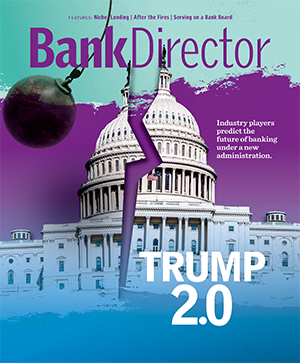
CRITICAL QUESTIONS DIRECTORS SHOULD ASK DURING M&A DUE DILIGENCE
A successful bank M&A strategy requires a thorough due diligence process, and bank directors can play an important role by asking the right questions.
Brought to you by Skadden

The prospect of a more receptive regulatory environment for bank M&A has led many small- and mid-size institutions to put M&A back on the table. For banks contemplating deals in 2025, there are two overarching questions:
1. How does the bank assess potential targets (or buyers)?
2. What roadblocks are there to getting a deal done?
Due diligence is an essential component to answering these questions.
Due Diligence Matters
A robust and accurate understanding of the key due diligence issues is critical not only for pricing a deal but planning for closing and integration. Without proper diligence, a buyer may acquire more than what was intended. For instance, buyers need to be aware of potential contractual disputes, unresolved compliance and enforcement actions or asset quality issues.
For buyers, a thorough diligence process involves identifying material risks and liabilities to inform the negotiation of key deal points, including representations and covenants.
For sellers, the process is an opportunity to engage and develop a relationship with a potential merger partner, illuminating pricing and other issues that support the parties moving forward. For transactions where merger consideration consists of equity securities of the acquirer, reverse due diligence is a necessity.
For buyers and sellers, robust due diligence is uniquely challenging given restrictions on sharing confidential supervisory information, such as exam ratings and adverse exam findings by regulators. It is essential that qualified bank regulatory counsel be retained to navigate these restrictions.
Key Areas of Focus
While there is no “one size fits all” approach to bank M&A diligence, there are several key areas of focus that should be addressed in detailed request lists, questionnaires, and calls across a variety of specialties. Successful acquirers leverage the resources and expertise of legal counsel and other advisers when conducting diligence, including on the topics highlighted below.
1. General corporate and legal matters. Understanding the target’s organizational structure is a foundational aspect of due diligence. Buyers should carefully examine the entity structure, including any subsidiaries, joint ventures or investments that may have financial or regulatory implications. The following factors should be considered:
- Corporate governance.
- Charter and bylaws.
- Outstanding equity and shareholder considerations.
- Material contracts and obligations.
- Litigation and legal risks.
- Tax issues.
2. Financial and credit. A thorough financial review is essential to understanding the true economic health of the target. Due diligence in this area should focus on:
- Projections, budgets or operating plans for future periods.
- Loan concentrations, nonperforming loans, charge-offs and overall credit risk exposure.
- Adequate allowances based on the target’s risk profile and lending practices.
- Capital reserves, liquidity sources and compliance with regulatory capital requirements.
- Sensitivity to interest rate fluctuations, including exposure to asset-liability mismatches.
- Contingent liabilities, commitments and guarantees that may impact financial health post-acquisition.
3. Compliance and risk management. Regulatory scrutiny remains a major factor in bank M&A, making it imperative to assess:
- Regulatory enforcement actions.
- Anti-money laundering and sanctions compliance.
- Consumer and Community Reinvestment Act compliance.
- Third-party risk management.
- Legal authority for activities.
4. Executive compensation and workforce. Understanding the target’s compensation structure and workforce dynamics is critical for talent retention and cultural integration. Key considerations include:
- Executive compensation agreements.
- Employee benefit plans.
- Retention and integration.
5. Branches, real estate, environmental and related issues. Real estate holdings and environmental risks should be reviewed carefully to avoid unexpected liabilities. Due diligence should include:
- Analyzing the branch network for potential closures, consolidations or expansion opportunities, including impact on local communities and engagement with community groups.
- Reviewing lease agreements, property titles and associated obligations.
- Determining whether environmental assessments need to be made on branches or other real estate owned properties to identify potential remediation obligations.
6. IT and operational resiliency. With increasing regulatory focus on cybersecurity and operational resiliency, banks should consider:
- Core banking systems.
- Privacy and cybersecurity frameworks.
- Business continuity and disaster recovery plans.
- Third-party IT dependencies.
Questions Bank Directors Should Ask
In the context of a potential transaction, bank directors can play an important role by asking the right questions of senior management, including:
- What are the most pressing diligence issues?
- What is outside counsel’s assessment of the materiality and probability of these issues?
- What are the mitigating actions that can be taken?
- How will the transaction documentation reflect what we have learned through diligence?
- Do any diligence issues change how management is viewing the overall transaction?
- Have we conducted a robust process and with adequate resources?



